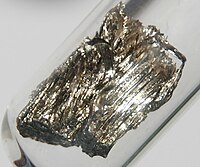
Photo from wikipedia
Abstract Jarosite is a common mineral in acidic, sulfate-rich environments where it is critical in regulating the acidity of aquatic systems and the mobility of trace elements and potential contaminants.… Click to show full abstract
Abstract Jarosite is a common mineral in acidic, sulfate-rich environments where it is critical in regulating the acidity of aquatic systems and the mobility of trace elements and potential contaminants. This research aims to understand jarosite formation and recrystallization in these environments by examining the stable iron isotope geochemistry of jarosite at two coastal sites in Victoria, Australia: Fossil Beach and Southside Beach. Jarosite occurs at high abundance as beds, veins, surface coatings and nodules within oxidized zones of sulfidic sediment outcrops and as pebbles, cobbles, and boulders at the base of the outcrops within the intertidal zone, making these two beaches ideal natural laboratories. Synchrotron powder X-ray diffraction (XRD) and ICP-MS results indicate that samples are comprised predominantly of natrojarosite, often with substantial K substitution. Rietveld refinement of XRD patterns shows that most jarosite samples are a solid-solution of Na-K jarosite, differing from previous observations that (near-)end-member mixing predominantly occurs in nature. The iron isotope composition of the jarosite samples have δ56Fe values between −1.91 and +1.24‰ (relative to IRMM-014), an exceptionally large range that partially overlaps with the δ56Fe values of the sulfidic sediment precursor (−0.54 to +1.30‰). There is a negative relationship between the alkali ratio [Na/(Na + K)] and iron isotope composition, with the heavier iron isotopes preferentially partitioned into K-rich jarosite. The large range in δ56Fe values of jarosite likely results from a combination of the variable δ56Fe values of the precursor sulfides, thermodynamic differences between Na- versus K-bearing jarosite, and an open-system Rayleigh distillation during jarosite formation.
Journal Title: Geochimica et Cosmochimica Acta
Year Published: 2020
Link to full text (if available)
Share on Social Media: Sign Up to like & get
recommendations!